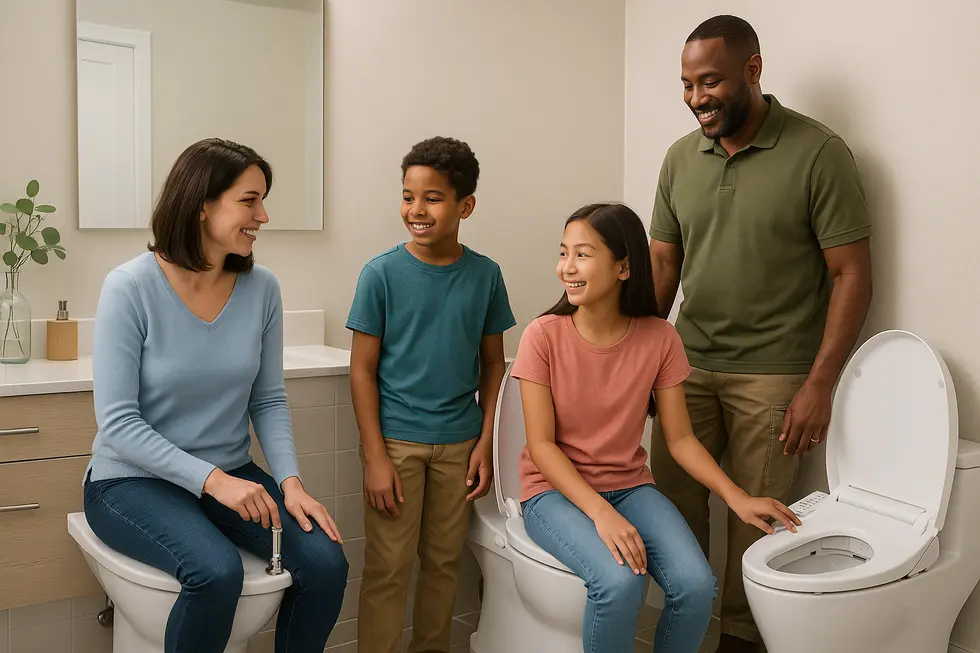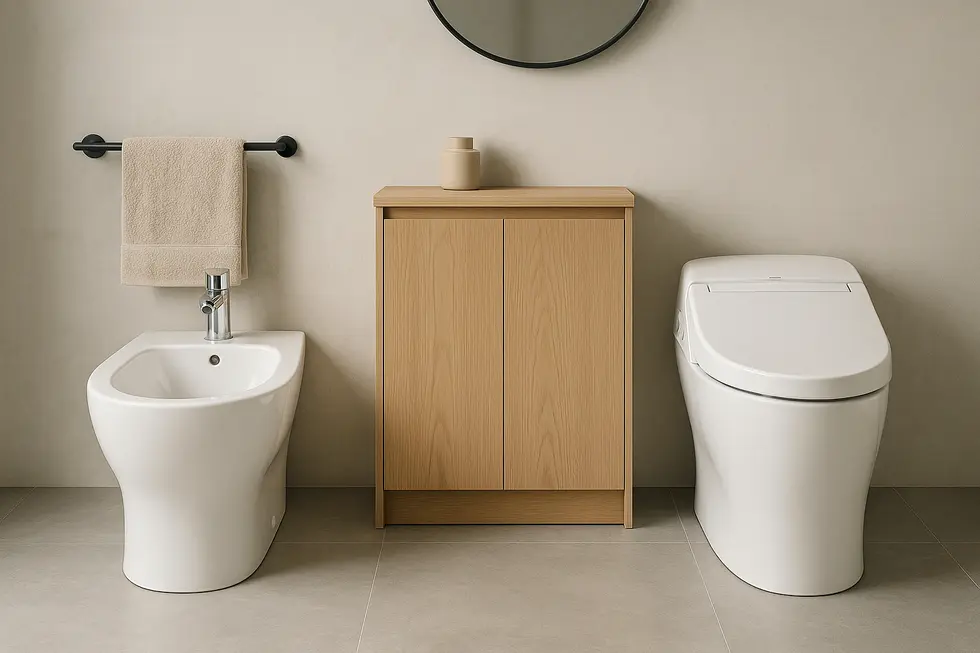Bidet Attachment
Bidet vs Washlet: A Comprehensive Guide for Families
As bathroom technology advances, families face new choices in personal hygiene solutions. Bidets and Washlets offer distinct features and benefits, influencing decisions about which to incorporate into the home. This guide explores the technological advancements, economic considerations, and societal perspectives on these systems, helping families make informed choices.
From Simple Spray to Smart Hygiene: How Technology Defines the Modern Bidet vs Washlet Debate

A decade ago, choosing between a bidet and a Washlet was simply a matter of deciding whether you wanted running water or toilet paper. Today the question is far more nuanced because micro-electronics, sensors, and software have transformed each option in very different ways.
Traditional bidets still lean on mechanical elegance: a manual lever adjusts pressure, and gravity or household water pressure does the rest. Yet even this category has quietly embraced innovation. Anti-bacterial nozzle coatings, quick-release hinges for easier cleaning, and eco-restrictors that trim water use without reducing flow now appear on many entry-level models. Users who prefer the reliability of plumbing over circuitry can even pair these upgrades with non-electric bidet attachments to bring a standard toilet up to hygienic speed without an outlet or batteries.
Washlets, by contrast, are essentially computers you sit on. A built-in microprocessor coordinates seat heating, instantaneous water heating, and self-cleaning UV LEDs. Advanced motion sensors detect approach, triggering a soft-open lid while pre-mist sprays the bowl to reduce staining. Once seated, pressure and temperature algorithms personalize the wash cycle; many models remember settings for every family member. After cleansing, a warm-air dryer powered by a ceramic element eliminates the need for paper, and a catalytic deodorizer scrubs the air before it escapes the bowl.
Behind these features sit safety and sustainability concerns. Modern Washlets include ground-fault protection, temperature limiters, and energy-saving modes that learn household routines and reduce standby wattage. Some even connect to Wi-Fi, allowing firmware updates that refine spray patterns or improve energy profiles over time. This connectivity also brings smart-home integration, letting users start a seat-warming session via voice assistant on cold mornings.
Ultimately, technology magnifies the philosophical split between the two fixtures. Bidets embrace straightforward, low-tech reliability with incremental hygienic advances; Washlets pursue full digital comfort, turning a daily necessity into an individualized spa ritual. Understanding these trajectories helps buyers match not just their budget, but their appetite for complexity, maintenance, and data-driven convenience—key factors that now shape the evolving conversation of bidet vs Washlet.
Counting the Drops and the Dollars: A Practical Cost Breakdown of Bidets vs. Washlets

How much does clean comfort really cost? The answer depends on where a household lands on the spectrum that stretches from portable sprayers to fully-featured Washlet seats. Portable units sit at the entry point, often costing little more than a dinner out. Because they need no plumbing changes or power source, their purchase price is essentially the entire investment. Travelers and renters appreciate that the total outlay rarely exceeds $100 and can be packed away the day a lease ends.
Next on the ladder are non-electric seat attachments. These slip beneath an existing toilet seat and connect to the water line with a simple T-valve. Most users can install them in under fifteen minutes with a wrench and a roll of plumber’s tape, keeping added labor at zero. Pricing hovers in the low hundreds, offering a hands-free cleanse without nudging the electricity bill.
Electric bidet seats elevate the experience with warming, pulsating sprays and gentle drying fans. Yet the jump in comfort is matched by a jump in expense. Units commonly land between $300 and $700, and they often demand a nearby GFCI outlet. If one isn’t available, an electrician must extend the circuit—an upgrade that can quietly add another $150–$250 to the project.
Washlets occupy the luxury tier. Their integrated warm-air dryers, deodorizing filters, and pre-mist features come in casings that can top four figures. Installation is rarely a DIY affair; professional plumbers and electricians coordinate to secure water, waste, and power connections. When labor, parts, and, in some bathrooms, a discreet outlet relocation are tallied, the total cost can double the sticker price.
Before deciding, homeowners should weigh not only retail cost but also permanence. A landlord may frown on hardwired fixtures, while an adventurer may need something that fits a backpack. To see how easily a renter can add a bidet to an existing toilet, explore our step-by-step guide.
Culture, Comfort, and Cost: How Society Shapes the Bidet vs Washlet Debate

Societal norms often decide what feels “normal” in a bathroom long before personal preference enters the conversation. In southern Europe, the freestanding porcelain bidet is almost a cultural artifact—found even in modest apartments—because post-toilet washing is viewed as a baseline for cleanliness. In Japan, however, rapid urbanization and a love of micro-electronics merged, giving rise to the Washlet. The result is a national expectation that a toilet offers warm water, a heated seat, and a gentle puff of drying air. These contrasting traditions reveal how culture frames our definition of hygiene.
Economic realities then refine those expectations. A traveler moving between hostels may prize the $30 squeeze-bottle bidet that tucks into a backpack, whereas a homeowner renovating a master suite might happily budget hundreds for a feature-rich Washlet. In regions where disposable income is limited or electricity unreliable, the simplicity of a manual bidet attachment retains clear appeal. Conversely, in tech-forward economies, the Washlet’s microprocessors turn a once-mundane fixture into a small piece of domestic luxury, much like a smart fridge or voice-controlled lighting.
Yet experience ultimately determines loyalty. Users who have sampled a warm seat on a frosty morning often say they can never go back, citing the unexpected comfort as well as hygienic confidence. Those who favor portability counter that independence from power outlets means reliable cleanliness wherever they go. People with limited mobility add another dimension: a Washlet’s oscillating nozzle and automatic drying reduce twisting, making daily routines safer and more dignified.
Interestingly, observed adoption patterns challenge stereotypes. Surveys show growing interest in North America, but a primary barrier is unfamiliarity; many households simply have not considered a water-based option. Cultural inertia is powerful, as explored in our deep dive on why many Western bathrooms still lack bidets. Once users overcome that initial hesitation—often after a hotel stay or a friend’s recommendation—the decisive factors become space, budget, and desired convenience level rather than nationality.
Brand perception mirrors this split. High-end manufacturers court luxury seekers with UV-sterilized nozzles and automatic lids, while value-oriented brands highlight durability and straightforward operation. Shoppers weighing these choices can compare feature sets across leading manufacturers at the detailed analysis provided here: https://premierbidets.com/blogs/news/toto-vs-american-standard
Final thoughts
In summary, choosing between a bidet and a Washlet involves evaluating technological benefits, cost implications, and user experiences. Families should weigh these factors based on their specific needs and preferences for comfort and convenience, ensuring a choice that enhances their daily hygiene routine.
Experience a new standard of clean with PEGABidet—designed for comfort, safety, and independence. Join thousands who trust us to make personal care simple and dignified. Contact us contact@pegabidet.com
About us
PEGABidet is a brand owned by L.A NEXTGEN LLC, based in California. We design intuitive, hygienic, and accessible bathroom solutions that prioritize safety, dignity, and independence. Our mission is to make personal care effortless and empowering for people at every stage of life.

